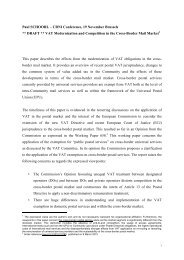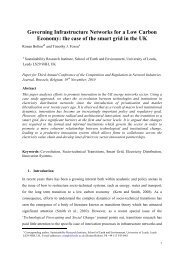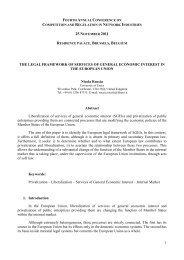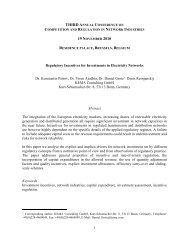Non-discriminatory Third Party Access to the Gas Transmission ...
Non-discriminatory Third Party Access to the Gas Transmission ...
Non-discriminatory Third Party Access to the Gas Transmission ...
Create successful ePaper yourself
Turn your PDF publications into a flip-book with our unique Google optimized e-Paper software.
vertically integrated and supplies non-integrated rivals with inputs as TPA services, it may have<br />
strong incentives <strong>to</strong> directly/indirectly:<br />
(a) Refuse <strong>to</strong> offer/provide non-<strong>discrimina<strong>to</strong>ry</strong> TPA and <strong>the</strong>reby benefit from <strong>the</strong> exit of <strong>the</strong><br />
competition firm.<br />
(b) Favour its own affiliates above that of non-integrated rivals in <strong>the</strong> terms and conditions<br />
for offered or provided services and <strong>the</strong>reby placing <strong>the</strong> rivals at a competitive disadvantage<br />
and benefit from that. The abuse may show itself in charging higher prices and degrading <strong>the</strong><br />
quality of <strong>the</strong> access services provided <strong>to</strong> downstream competi<strong>to</strong>rs and numerous covert<br />
methods of discrimination, such as manipulating rate categories or capacity allocation, longterm<br />
exclusive dealing, fidelity rebates and similar practices, abusing commercial information<br />
or cross-subsidizing. 43<br />
The second type of <strong>discrimina<strong>to</strong>ry</strong> TPA concerns discrimination by a TSO amongst cus<strong>to</strong>mers<br />
(anti-rivals) with whom <strong>the</strong> TSO is not in competition. This type of discrimination aims at equal<br />
opportunities for all system users in order <strong>to</strong> institute a system that ensures competition is not<br />
dis<strong>to</strong>rted. In this situation <strong>the</strong> TSO has no obvious interest in taking actions that would affect <strong>the</strong><br />
competiveness of one cus<strong>to</strong>mer when compared <strong>to</strong> ano<strong>the</strong>r cus<strong>to</strong>mer. One could even argue; <strong>the</strong><br />
more (satisfied) cus<strong>to</strong>mers <strong>the</strong> better, because a TSO would gain no advantage by discriminating<br />
amongst cus<strong>to</strong>mers (anti-rivals) and might even suffer a disadvantage through a reduction in its<br />
sales. However, this does not suggest -when discrimination of this type occurs- that <strong>the</strong> TSO is<br />
likely <strong>to</strong> have a valid reason for this discrimination. TSOs may have incentives <strong>to</strong> direct/indirect<br />
distinguish between cus<strong>to</strong>mers (anti-rivals):<br />
(a) For efficiency considerations; for example, different treatment in terms and conditions<br />
based on <strong>the</strong> volume of purchase of TPA services (such as quantity rebates);<br />
(b) For strategic reasons; for example, different treatment based on whe<strong>the</strong>r or not a TSO<br />
cooperates with a system user during a project. For example, in building new pipelines<br />
(preserve a good relationship with business partners);<br />
(c) As part of a strategy <strong>to</strong> divide markets in order <strong>to</strong> be able <strong>to</strong> exploit market power better<br />
on <strong>the</strong> long term. 44 The abuse may take on <strong>the</strong> shape of exploitative abuse, a conduct which is<br />
43 JONES, C.W. (2005) EU Energy law Volume 1: The Internal Energy Market. Leuven: Claeys & Casteels, p. 61-<br />
62. GERADIN, D. (2000) The Liberalization of State Monopolies in <strong>the</strong> European Union and Beyond. London:<br />
Kluwer Law International, p.10.<br />
44 Irish sugar (Case T-228/97) [1999], paragraphs 123 and 151-154.<br />
10







